LIXIL makes pioneering water and housing products that solve everyday, real-life challenges, making better homes a reality for everyone, everywhere.
- Global Site
-
- English
- Japanese
- Brand Sites
Global
- Global Site
-
- English
- Japanese
- Brand Sites
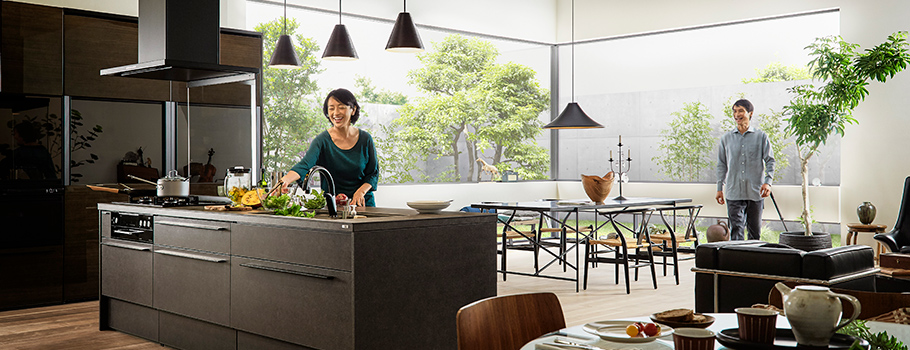
Updated: Dec 14, 2017
In Japan, people are sharing photos and videos of their kitchens and cooking on social media. The spread of smartphones has led to constant connectivity and increased use of social media, allowing private moments such as meals and family time at home to be aired around the world.
"This new environment has transformed cooking from mere housework to center-stage entertainment, and today's kitchens serve as an attractive backdrop for sharing one's moments," says Sadao Tsuchiya, a housing and lifestyle researcher.
But it is not just communications that is becoming more open, but also the kitchens themselves. According to Tsuchiya, kitchens have undergone continual change, reflecting the times and people's lifestyles.
Designs that reflect the times
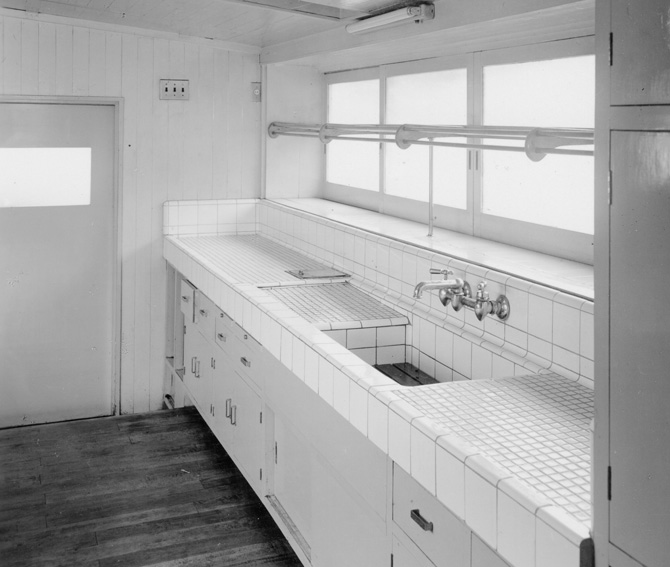 A 1950s open kitchen (© LIXIL Museum)
At one time, entrances to Japanese homes had floors of hardened earth on which a wood-burning stove and sink were fitted. This is where the cooking took place. Kitchens continued to evolve, but it was in the post-war reconstruction period of the 1950s when there was significant change. To help solve the housing shortage, apartment complexes began to tower above traditional homes. In these apartments, people gradually turned to Western-style dining and kitchen (DK) room layouts, combining what had previously been an area for cooking (the kitchen) with a space to share meals (the dining room) in a single room. It wasn't long before the Living-Dining-Kitchen (LDK) concept emerged – a kitchen seamlessly integrated with the dining room and living room. Reflecting the times and the way that people were seeking to interact socially, the kitchen in Japan had become part of the center of the home, where the family spends much of its time.
A 1950s open kitchen (© LIXIL Museum)
At one time, entrances to Japanese homes had floors of hardened earth on which a wood-burning stove and sink were fitted. This is where the cooking took place. Kitchens continued to evolve, but it was in the post-war reconstruction period of the 1950s when there was significant change. To help solve the housing shortage, apartment complexes began to tower above traditional homes. In these apartments, people gradually turned to Western-style dining and kitchen (DK) room layouts, combining what had previously been an area for cooking (the kitchen) with a space to share meals (the dining room) in a single room. It wasn't long before the Living-Dining-Kitchen (LDK) concept emerged – a kitchen seamlessly integrated with the dining room and living room. Reflecting the times and the way that people were seeking to interact socially, the kitchen in Japan had become part of the center of the home, where the family spends much of its time.
A shared space
The empowerment of women in Japanese society is said to have played a role in this shift. Traditionally, domestic chores were considered the domain of the housewife, but the number of women in the labor force has risen considerably in Japan. According to the government, the number of dual-income households now exceeds those with non-working mothers¹. As a result, housework is increasingly considered to be a collaborative effort, eschewing traditional roles in which husbands work outside while wives focus on child-rearing and the home.
According to a LIXIL survey², 45% of husbands cook or clean the dishes every weekday or at least 3-4 times per week. More than half answered that they do so every weekend or 2-3 times a month on days off. Men in their 20s showed the highest level of participation, with 70% of respondents indicating that they cooked or cleaned the kitchen every weekday or at least 3 times per week. Demonstrating a generation gap, men in their 50s contributed the least to household chores.
Attitudes towards cooking have also changed. A highly creative art, cooking is now seen less as "something that has to be done" and increasingly as "a pastime to be enjoyed." When asked why they participated in housework, the most common response from husbands was that they were in a 'dual-income couple' (30%), but approximately one in five said they did it because they 'enjoyed cooking'.
With these changes in Japanese society, the kitchen has increasingly become a space at the center of the home that serves as a hub for communications and where cooking duties are shared among the couple or family.
Open kitchens designed to reflect lifestyles
Today, we can observe a wider variety of designs for open kitchens, reflecting the values and lifestyle of each family.
"Kitchens are where people cross paths, come together, and where communication starts," says architect Osamu Nishida. In one of Nishida's designs, the kitchen is located at the center of the home and visible from all areas. With two stoves and two sinks, it is designed so the family can easily talk to each other. In another example, the kitchen is placed between the living and dining rooms, where people's paths regularly intersect.
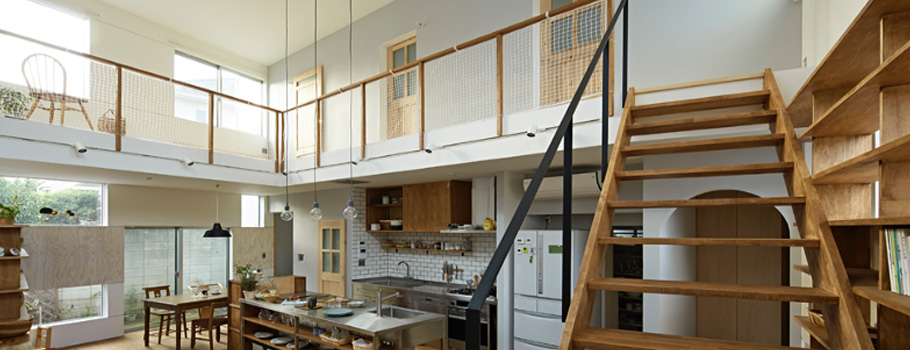
Osamu Nishida's open kitchen design (design: Osamu Nishida + Yuko Kaminaga, photo: Koichi Torimura)

Osamu Nishida's open kitchen design (design: Osamu Nishida + Yuko Kaminaga, photo: Koichi Torimura)
For architect Yuko Nagayama, "not every part of an open kitchen has to be openly visible." Nagayama's designs intentionally conceal the food preparation space from view while still retaining an open feel of the kitchen. The stove is located against the wall to allow greater concentration on the more dangerous stages of cooking, while the sink faces the dining table in an open design featuring an island.
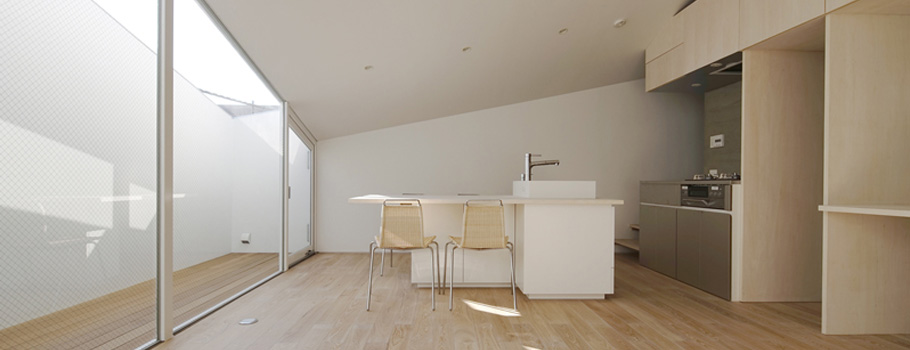
Yuko Nagayama's open kitchen design (design: Yuko Nagayama, photo: Daichi Ano)
"As a child, cleaning up after meals with my mother gave us time to talk properly," says Nagayama. While preparing food, Nagayama's mother would focus on the task at hand, but after the meal, cleaning up allowed her to take a breath and ask her daughter about the day at school. Placing the sink so it faces the dining area enables conversation while washing dishes or preparing food.
Amid growing demand for kitchen-centered lifestyles, LIXIL launched its Richelle PLAT system kitchen, which provides a place to gather for meals without the need for a dining table. By integrating the table with the kitchen counter, Richelle PLAT enables dishes to be set or cleared away easily, making housework more efficient but also creating a new space to cook, eat, work, and relax. By doing away with the need for a large dining table, this design also allows more space for the living room.
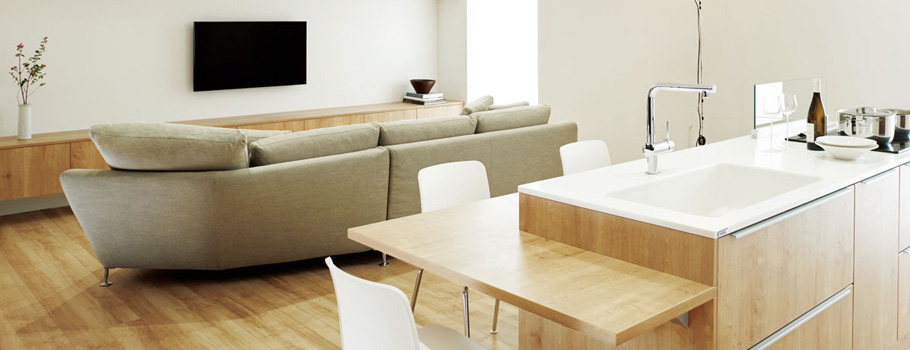
LIXIL's system kitchen, Richelle PLAT
The future kitchen will reflect who we are
Kitchens have become a place to enjoy cooking, meals, and precious conversations with family and friends. And no doubt, they will continue to change with the times.
"Japan has gone from a time of focusing on economic growth to a mature society where spiritual enrichment and improving quality of life are the greatest priorities," says Tsuchiya.
"People have come to place emphasis on what they eat, how they live, and with whom. The ideal kitchen differs for every person, but I believe it will continue to gain greater importance as a place for communication with family and friends," he adds.
1 White Paper on Gender Equality 2016
(http://www.gender.go.jp/about_danjo/whitepaper/h28/gaiyou/html/honpen/b1_s03.html)
2 Kitchen Kaigi Survey "Husband Participation in Housework (4th) – State of various domestic chores"
(https://www.lixil.co.jp/square/kitchen-kaigi/column55/)
Our Stories
- Backing People and Passions to Drive Innovation
- How Toilets in Schools are Catalyzing Change in Communities
- Building the Future by Recycling the Past
- Reinventing Consumer Connections in the World's Largest E-commerce Market
- Tackling Household Water Inefficiency in a Water-Stressed World
- Plugging the Plumber Shortage
- Pioneering Solutions to a Sewage Crisis in Rural Alabama
- Meet the Citizen Developers Changing How We Work
- Design and Brand Identity Transformation at LIXIL
- Three Changes to Prepare Europe’s Sanitary Industry for Growth
- Three Steps to Creating an Inclusive Culture
- From Linear to Circular: Giving Products in Your Home a New Lease of Life
- Crafting Unique Experiences as well as Products
- GROHE X: A Digital Brand Experience
- Design-led Innovation Delivering True Value
- Responsible Use of Plastics
- Empowering our People for an Agile Future
- Turning the Waves of Change into Opportunities
- SATO Tap: a New Handwashing Solution for All
- New Ways of Working Take Flight at LIXIL
- INAX: Rituals of Water
- Refreshing our sanitation targets, standing firm on our commitments
- Developing Attractive and Differentiated Products
- Conserving Water: The New Normal
- Insulating For a Warmer and Healthier Home
- Open Kitchen, Open Communication
- Tackling Open Defecation in India
- Shaping the Future of Faucets, One 3D Layer at a Time
- Bathed in Culture and Tradition
- Remodeling the Housing Market
- LIXIL's AQUA CERAMIC makes bathroom stains a thing of the past
- The Technology of Water
- Tackling Challenges in Global Sanitation and Hygiene
